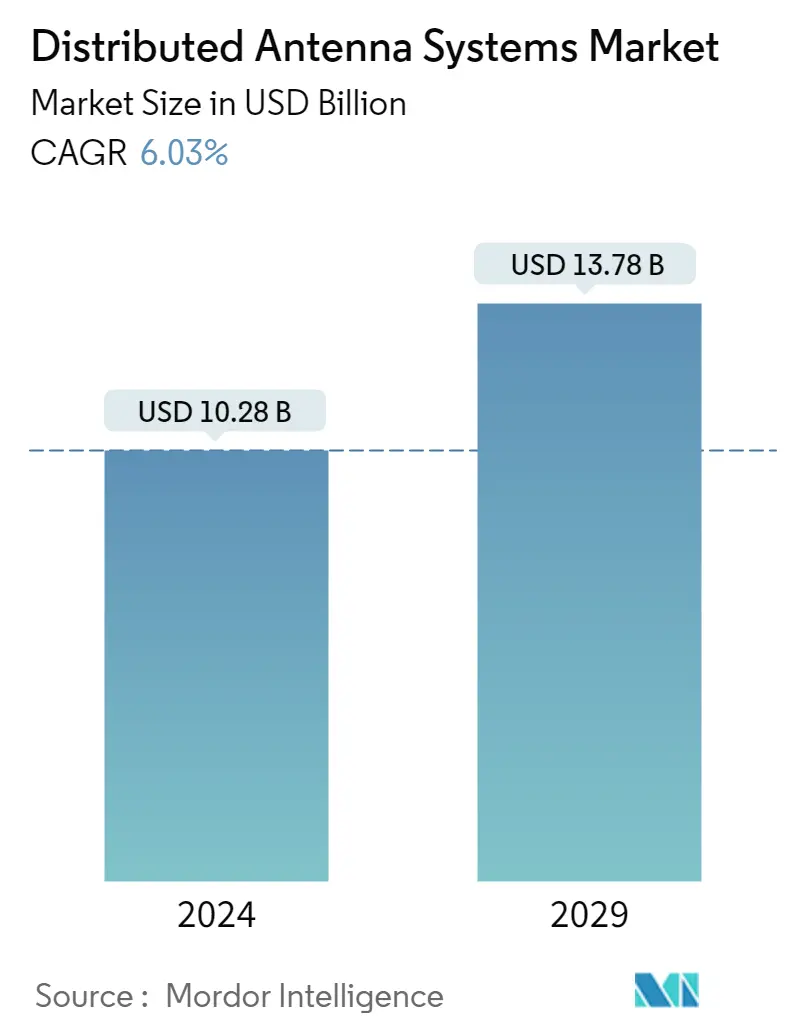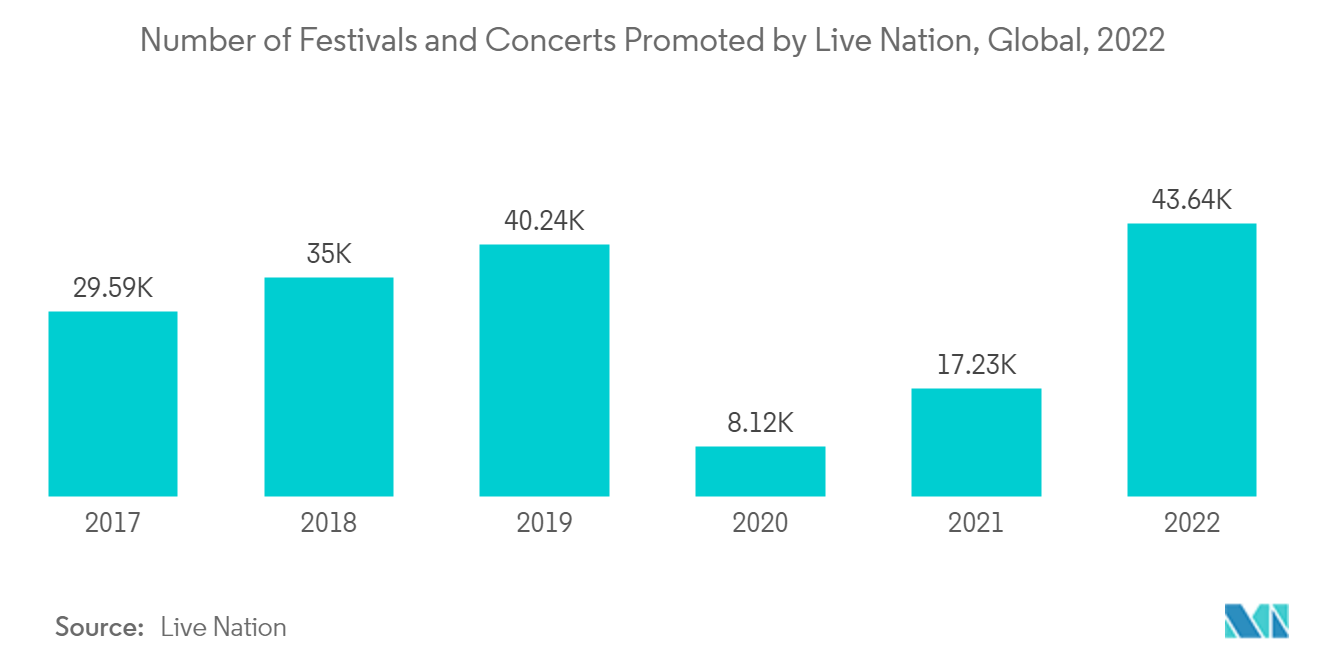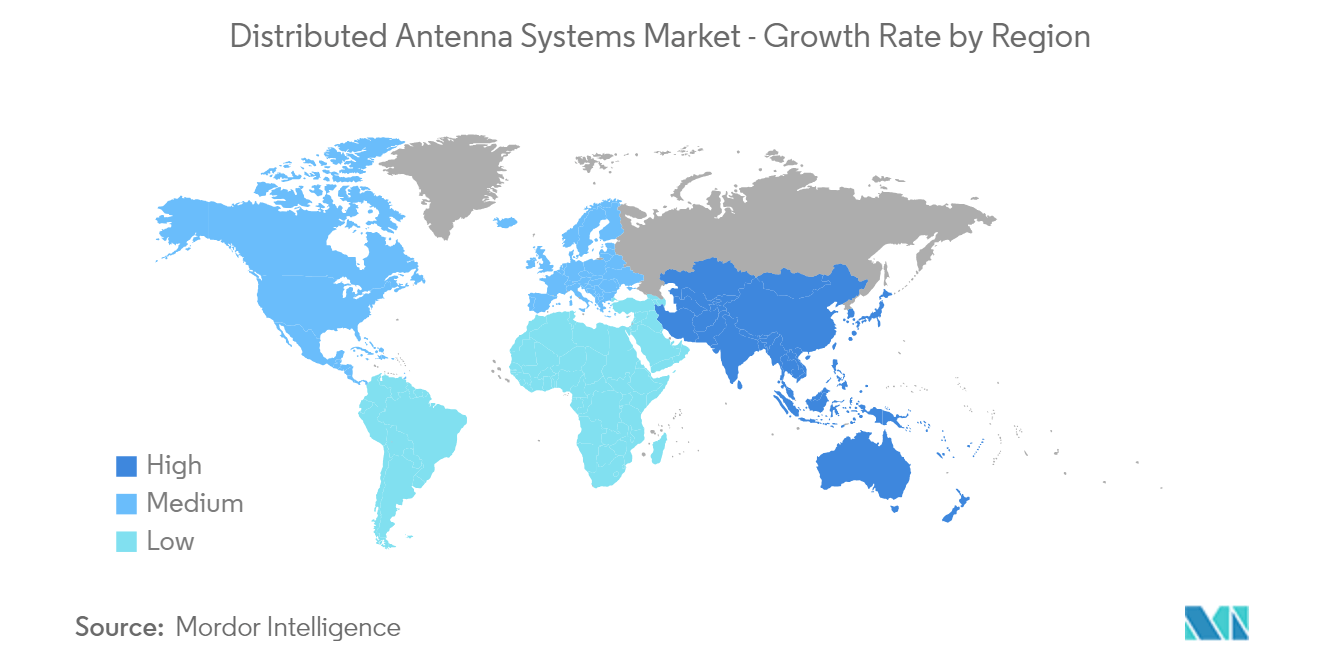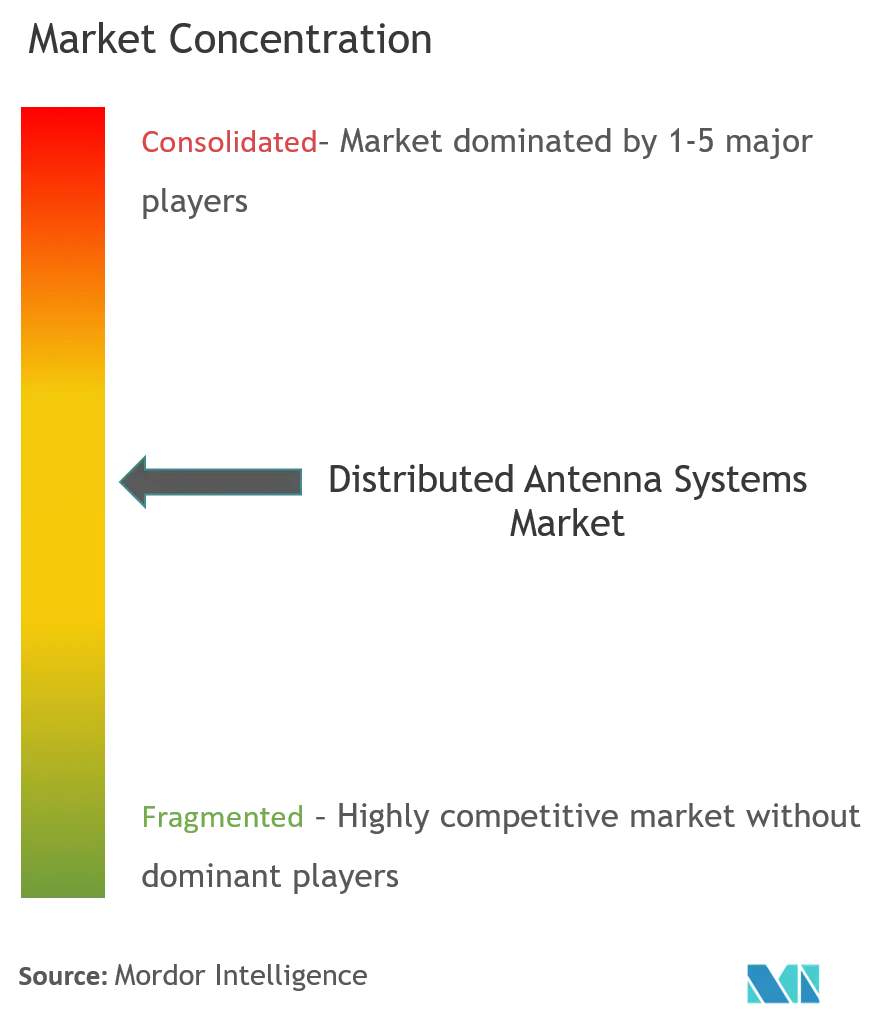Distributed Antenna Systems Market Size

| Study Period | 2019 - 2029 |
| Market Size (2024) | USD 10.28 Billion |
| Market Size (2029) | USD 13.78 Billion |
| CAGR (2024 - 2029) | 6.03 % |
| Fastest Growing Market | Asia Pacific |
| Largest Market | North America |
Major Players.webp)
*Disclaimer: Major Players sorted in no particular order |
Need a report that reflects how COVID-19 has impacted this market and its growth?
Distributed Antenna Systems Market Analysis
The Distributed Antenna Systems Market size is estimated at USD 10.28 billion in 2024, and is expected to reach USD 13.78 billion by 2029, growing at a CAGR of 6.03% during the forecast period (2024-2029).
The developments in communication technology that have led to the evolution of high-speed connectivity, lesser power-consuming network devices, and more substantial connectivity coverage have boosted the market for DAS systems. Additionally, the rising demand for stable and uninterrupted connectivity and the growing number of connected devices support the studied market's growth.
- The concept of distributed antenna systems has been there for many years, and the surged usage of wireless networks in buildings with potential applications in smart homes and connected devices has further promoted the implementation of DAS systems in the market as it facilitates several advantages over single-antenna systems, allowing businesses to get the coverage essential for applications.
- Moreover, while customers expect ubiquitous high-quality voice coverage, the rapidly growing use of data and video-driven applications redefine DAS systems' role.
- The wireless industry consistently strives to keep pace with the growing demand for higher bandwidth and surging data usage for high-speed applications by incorporating LTE standards and the LTE-Advanced (LTE-A) standards. Depending on macro cellular networks alone could not efficiently meet the requirements of the last generation of applications. This has further focused on the need to deploy DAS networks for accommodating user demands such as services in offices, stadiums, homes, airports, and high-rises.
- Furthermore, DAS has turned out to be more than an indoor network coverage solution in regard to voice calls. For instance, in smart cities, DAS has turned out to be a crucial solution in aiding to creation of the needed infrastructure for achieving connected systems. Various infrastructures such as smart buildings, shopping complexes, hospitals, and vehicular traffic management require continuous communication; thus, this is expected to propel market demand.
- However, the cost of distributed antenna systems is among the major factors challenging the studied market's development, as the price of a DAS solution is determined based on the time and range. For instance, passive DAS utilized for identifying the coverage of cellular carriers consistently is at the lower end and may cost only a couple of hundreds or thousands of dollars; on the contrary, active DAS utilized for increasing in-building coverage of one or more mobile service provider networks that is available at higher costs.
- Moreover, during the COVID-19 crisis, essential technologies played an essential role in keeping society functional during lockdowns and quarantines. In addition to this, DAS and other related technologies are expected to have a long-lasting impact. Furthermore, continuous monitoring for the evolving signs of a possible new world order post-COVID-19 crisis is essential for aspiring businesses, and the significant players are looking forward to finding success in the now-changing Distributed Antenna Systems (DAS), which is expected to propel investments, supporting the growth of the studied market during the forecast period.
Distributed Antenna Systems Market Trends
Sport and Entertainment Segment to Hold a Significant Market Share
- Distributed Antenna Systems (DAS) provide wireless service via an antenna system, mainly to large infrastructural establishments such as sports complexes, stadiums, etc., to provide even connectivity and to ensure that emergency responders maintain wireless communications within a building structure and on-the-job in emergencies, considering large gatherings at these places.
- Currently, sports and entertainment fans expect uninterrupted wireless service that can enable them to quickly and easily stay connected with their friends and family while enjoying any live event. Moreover, updating social media, sharing photos and videos, sending texts, and placing calls are integral and expected parts of experiencing a live event. However, stadiums and arenas have presented unique challenges for mobile communications due to their size, shape, and variation in data use.
- The in-building wireless solutions have solved these unique challenges of stadiums and arenas to ensure that spectators always have reliable connectivity. Using DAS systems, stadiums can also equip their security personnel and public safety first responders with mission-critical communication resources supporting both cellular and public safety bands.
- Moreover, 5G technology impacts almost every aspect of people's lives, including fans' experience at any sports and entertainment venue. New stadiums are being built with 5G-ready technologies taken into consideration from the beginning, while multiple existing platforms are also incorporating them to keep up with fans' expectations and streamline connectivity through innovative solutions.
- Furthermore, the increasing number of sporting and entertainment events being organized globally, driving investment in the construction of new stadiums and sports and entertainment complexes, are expected to create a favorable market scenario for the studied market growth. For instance, Live Nation, a leading event organization, organized about 17,234 events worldwide in 2021. Although the number has declined primarily due to COVID-19, it is expected to gain traction during the forecast period.

Asia-Pacific to Witness Highest Growth
- Owing to the rapidly increasing construction of high-rise residential buildings and commercial spaces, such as malls and business parks, coupled with the multiple government initiatives, such as Smart Nation Singapore and Smart Cities Mission India, among others, with a growing volume of 4G enabled smartphones, the rising popularity of Bring Your Own Device trends have been some of the other factors that are driving the region’s DAS market.
- The recent advancements in cellular technology are one of the major factors for the region’s excellent growth over the forecast period. This can be attributed to the growing number of planned deployments of LTE networks in emerging economies. Also, the virtualization of mobile networks and the rapid adoption of open APIs are other factors contributing to the market’s growth.
- Asia-Pacific has been a region of contrasts. Advanced markets such as South Korea and Japan have had network densification projects for 5G for the past few years. The highly urbanized Chinese administrative regions of Hong Kong and Macau and the city-state of Singapore are comparable in their extensive usage of small cells and DAS. On the other hand, the development curve in emerging markets such as India and Indonesia which are still relying on the traditional macro-towers in order to cover their large rural populations. The Maldives and the Pacific island nations are also an example of this group, eschewing towers altogether in favor of even less expensive satellite-based mobile networks.
- Hence, Mainland China, South Korea, and Japan are currently the largest tower markets in the region. However, tower coverage in these markets has already reached the majority of the population, which implies that future tower growth would significantly rely on network densification in urban areas through the usage of small cells and DAS.
- The region is also witnessing several partnerships and collaborations, paving the way for further technological evolution. For instance, Nokia and China Mobile have jointly developed this 5G low-cost hybrid distributed indoor system in order to meet these challenges. The smart indoor coverage system leverages the Nokia 5G Pico Remote Radio Head system together with the passive DAS antennas and Bluetooth Low Energy (BLE) technology. This new solution also reduces deployment costs as compared to the traditional passive-only DAS systems while delivering greater capacity than DAS.

Distributed Antenna Systems Industry Overview
The distributed antenna systems market is moderately competitive; however, the competition is expected to grow owing to the increasing mobile data traffic, the proliferation of connected devices due to the Internet of Things (IoT), the rising need for spectrum efficiency, and the growing consumer demand for extended network coverage and uninterrupted connectivity. Many companies are now entering the market with an array of scopes. Some of the key players in the market are Anixter, CommScope, TE Connectivity, Corning Inc., and American Tower Corporation. Some recent developments in the market include:
In December 2022, Real Betis Balompié football club announced a partnership with Cellnex, a wireless telecommunication and broadcasting infrastructure provider, to develop the club's digital infrastructure and provide the best digital experience for its fans. As per this agreement, Cellnex installed a distributed antenna system (DAS) at the Benito Villamarín Stadium.
In November 2022, Advanced RF Technologies (ADRF), a leading pure-play distributed antenna system (DAS) and repeater provider, launched its new ADXV DAS C-band solution and the SDRX C-band repeater. The ADXV DAS C-band modules include high-power remote (HPR) and mid-power remote (MPR) options supporting C-band frequencies ranging from 3.7 GHz to 3.98 GHz and allow building owners, mobile carriers, system integrators, and neutral hosts to bring ubiquitous 5G coverage for buildings and venues of every size.
Distributed Antenna Systems Market Leaders
Anixter Inc.
CommScope Inc.
TE Connectivity Ltd
American Tower Corporation
SOLiD Inc.
*Disclaimer: Major Players sorted in no particular order

Distributed Antenna Systems Market News
- July 2023: American Tower Corporation and Xcel Energy Center announced the deployment of a Distributed Antenna System (DAS) solution that will bring 5G technology to the arena. The company enters a new era of fan engagement and provides cutting-edge applications for the Minnesota Wild fans, with an updated, neutral-host 5G DAS.
- October 2022: PROSE Technologies, a wireless antenna, transmission, capacity, and coverage solution provider, announced a new Active DAS system for the 5G network. The company also announced the launch of its first 5G in-building DAS in one of the biggest commercial complexes in Mumbai, India.
Distributed Antenna Systems Market Report - Table of Contents
1. INTRODUCTION
1.1 Study Assumptions and Market Definition
1.2 Scope of the Study
2. RESEARCH METHODOLOGY
3. EXECUTIVE SUMMARY
4. MARKET DYNAMICS
4.1 Market Overview
4.2 Industry Value Chain Analysis
4.3 Industry Attractiveness - Porter's Five Forces Analysis
4.3.1 Bargaining Power of Suppliers
4.3.2 Bargaining Power of Buyers
4.3.3 Threat of New Entrants
4.3.4 Threat of Substitute Products
4.3.5 Intensity of Competitive Rivalry
4.4 Impact of COVID-19 on the Market
5. MARKET DYNAMICS
5.1 Market Drivers
5.1.1 DAS Ability to Support Multiple Telecom Carriers and Upcoming Technologies
5.2 Market Challenges
5.2.1 High Cost to Upgrade challenges the Market Growth
6. MARKET SEGMENTATION
6.1 By Type
6.1.1 Active
6.1.2 Passive
6.1.3 Digital
6.1.4 Hybrid
6.2 By End-User
6.2.1 Manufacturing
6.2.2 Healthcare
6.2.3 Government
6.2.4 Transportation
6.2.5 Sports and Entertainment
6.2.6 Telecommunications
6.2.7 Other End-Users
6.3 By Application
6.3.1 Enterprise DAS
6.3.2 Public Safety DAS
6.3.3 Other Applications
6.4 Geography
6.4.1 North America
6.4.2 Europe
6.4.3 Asia-Pacific
6.4.4 Latin America
6.4.5 Middle East & Africa
7. COMPETITIVE LANDSCAPE
7.1 Company Profiles
7.1.1 Anixter Inc.
7.1.2 Cobham PLC
7.1.3 Antenna Products Corporation
7.1.4 CommScope Inc.
7.1.5 Tower Bersama Group
7.1.6 SOLiD Inc.
7.1.7 TE Connectivity Ltd.
7.1.8 Corning Inc.
7.1.9 Comba Telecom Systems Holdings Ltd.
7.1.10 Boingo Wireless Inc.
7.1.11 American Tower Corporation
- *List Not Exhaustive
8. INVESTMENT ANALYSIS
9. FUTURE OUTLOOK OF THE MARKET
Distributed Antenna Systems Industry Segmentation
The DAS is a network of antennas spaced apart from each other and connected to a familiar source. DAS uses this feature to provide wireless or radio coverage within a given area. It can be deployed in densely populated areas like malls and provide high bandwidth without installing micro or small cells. Security, health care, and building communication are among the primary end-user segments driving the market and industrial applications.
The study provides a detailed analysis of key trends and emerging market opportunities in the market by segmenting the market by type, such as active, passive, digital, and hybrid; end-users such as manufacturing, telecommunications, healthcare, government, transportation, sports, and entertainment; application like enterprise DAS, public safety DAS; and geography (North America, Europe, Asia-Pacific, Latin America, the Middle East, and Africa).
The market sizes and forecasts are provided in terms of value (USD) for all the above segments.
| By Type | |
| Active | |
| Passive | |
| Digital | |
| Hybrid |
| By End-User | |
| Manufacturing | |
| Healthcare | |
| Government | |
| Transportation | |
| Sports and Entertainment | |
| Telecommunications | |
| Other End-Users |
| By Application | |
| Enterprise DAS | |
| Public Safety DAS | |
| Other Applications |
| Geography | |
| North America | |
| Europe | |
| Asia-Pacific | |
| Latin America | |
| Middle East & Africa |
Distributed Antenna Systems Market Research FAQs
How big is the Distributed Antenna Systems Market?
The Distributed Antenna Systems Market size is expected to reach USD 10.28 billion in 2024 and grow at a CAGR of 6.03% to reach USD 13.78 billion by 2029.
What is the current Distributed Antenna Systems Market size?
In 2024, the Distributed Antenna Systems Market size is expected to reach USD 10.28 billion.
Who are the key players in Distributed Antenna Systems Market?
Anixter Inc., CommScope Inc., TE Connectivity Ltd, American Tower Corporation and SOLiD Inc. are the major companies operating in the Distributed Antenna Systems Market.
Which is the fastest growing region in Distributed Antenna Systems Market?
Asia Pacific is estimated to grow at the highest CAGR over the forecast period (2024-2029).
Which region has the biggest share in Distributed Antenna Systems Market?
In 2024, the North America accounts for the largest market share in Distributed Antenna Systems Market.
What years does this Distributed Antenna Systems Market cover, and what was the market size in 2023?
In 2023, the Distributed Antenna Systems Market size was estimated at USD 9.70 billion. The report covers the Distributed Antenna Systems Market historical market size for years: 2019, 2020, 2021, 2022 and 2023. The report also forecasts the Distributed Antenna Systems Market size for years: 2024, 2025, 2026, 2027, 2028 and 2029.
Distributed Antenna Systems Industry Report
Statistics for the 2024 Distributed Antenna Systems market share, size and revenue growth rate, created by Mordor Intelligence™ Industry Reports. Distributed Antenna Systems analysis includes a market forecast outlook 2029 and historical overview. Get a sample of this industry analysis as a free report PDF download.
